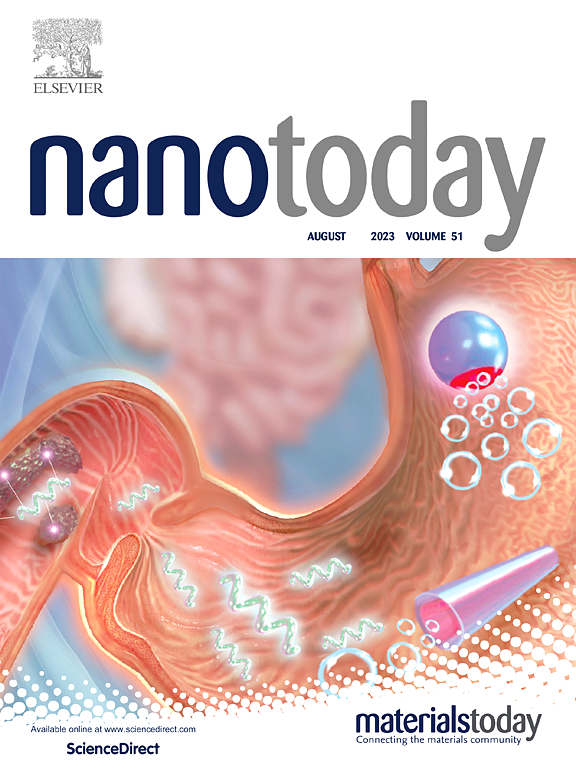Nanotechnology for diagnosis and therapy of idiopathic pulmonary fibrosis: Recent advances and future perspectives
IF 10.9
1区 材料科学
Q1 CHEMISTRY, MULTIDISCIPLINARY
引用次数: 0
Abstract
Idiopathic pulmonary fibrosis (IPF) is a highly progressive interstitial lung disease characterized by alveolar epithelial cell damage, extracellular matrix deposition, and irreversible lung parenchymal scarring, ultimately leading to fatal respiratory failure. Early diagnosis and effective intervention of IPF are crucial for improving its prognosis and reducing mortality. Current diagnostic methods for early-stage IPF rely on high-resolution CT, histopathological examination, and multidisciplinary discussions. However, these approaches have significant limitations, including poor accuracy, invasiveness, and being time-consuming, which often delays therapeutic intervention. Furthermore, existing pharmacotherapy offer only limited efficacy in slowing disease progression due to the low bioavailability and limited delivery efficiency. To address these challenges in diagnostics and therapeutics, nanotechnology-mediated solutions have emerged as promising approaches. Contemporary advancement focuses on three domains: (1) development of functionalized nano-contrast agents, nanoprobe- and nanoparticle-based biosensor platforms for in vivo and in vitro precision diagnostics, (2) design of nanocarriers for inhalable drug delivery to enhance therapeutic efficacy, and (3) integrated nanoplatforms enabling simultaneous therapeutic delivery and real-time monitoring for targeted intervention. Overall, this review summarized recent advancements in nanotheranostic applications for the diagnosis and therapy of IPF. Moving forward, future research prioritize overcoming translational barriers to facilitate clinical implementation.
纳米技术用于特发性肺纤维化的诊断和治疗:最新进展和未来展望
特发性肺纤维化(IPF)是一种高度进行性肺间质性疾病,其特征是肺泡上皮细胞损伤、细胞外基质沉积和不可逆的肺实质瘢痕形成,最终导致致命的呼吸衰竭。IPF的早期诊断和有效干预是改善其预后和降低死亡率的关键。目前早期IPF的诊断方法依赖于高分辨率CT、组织病理学检查和多学科讨论。然而,这些方法有明显的局限性,包括准确性差、侵入性和耗时,这往往会延迟治疗干预。此外,由于低生物利用度和有限的递送效率,现有的药物治疗在减缓疾病进展方面的疗效有限。为了解决诊断和治疗中的这些挑战,纳米技术介导的解决方案已经成为有希望的方法。当前的进展主要集中在三个领域:(1)开发功能化纳米造影剂、纳米探针和纳米颗粒为基础的生物传感器平台,用于体内和体外精确诊断;(2)设计可吸入药物递送的纳米载体,以提高治疗效果;(3)集成纳米平台,使治疗递送和实时监测靶向干预成为可能。综上所述,本文综述了近年来纳米治疗在IPF诊断和治疗中的应用进展。展望未来,未来的研究将优先考虑克服翻译障碍,以促进临床应用。
本文章由计算机程序翻译,如有差异,请以英文原文为准。
求助全文
约1分钟内获得全文
求助全文
来源期刊

Nano Today
工程技术-材料科学:综合
CiteScore
21.50
自引率
3.40%
发文量
305
审稿时长
40 days
期刊介绍:
Nano Today is a journal dedicated to publishing influential and innovative work in the field of nanoscience and technology. It covers a wide range of subject areas including biomaterials, materials chemistry, materials science, chemistry, bioengineering, biochemistry, genetics and molecular biology, engineering, and nanotechnology. The journal considers articles that inform readers about the latest research, breakthroughs, and topical issues in these fields. It provides comprehensive coverage through a mixture of peer-reviewed articles, research news, and information on key developments. Nano Today is abstracted and indexed in Science Citation Index, Ei Compendex, Embase, Scopus, and INSPEC.
 求助内容:
求助内容: 应助结果提醒方式:
应助结果提醒方式:


